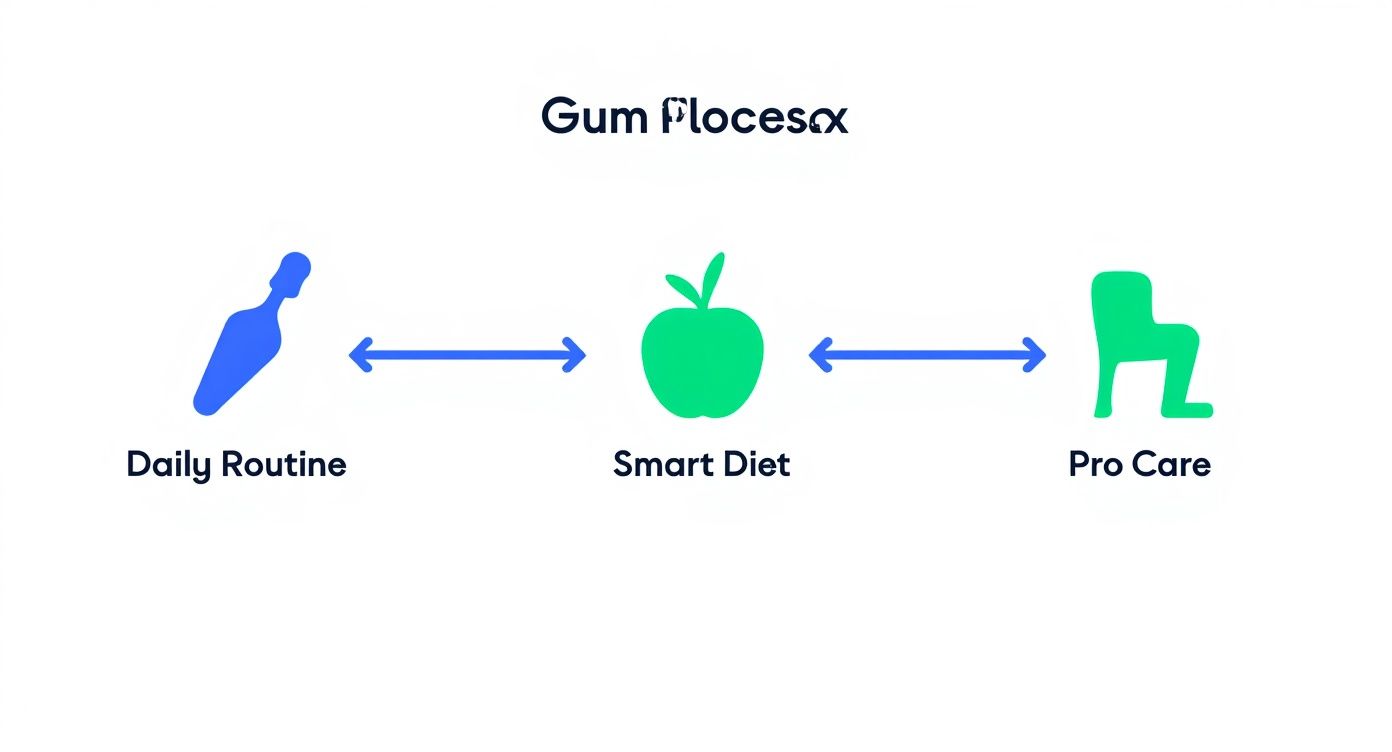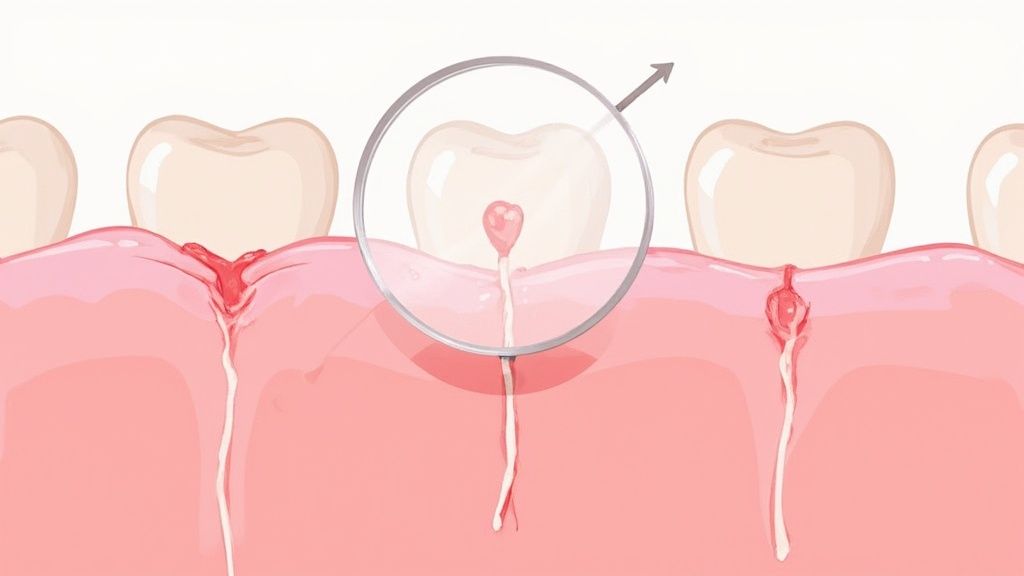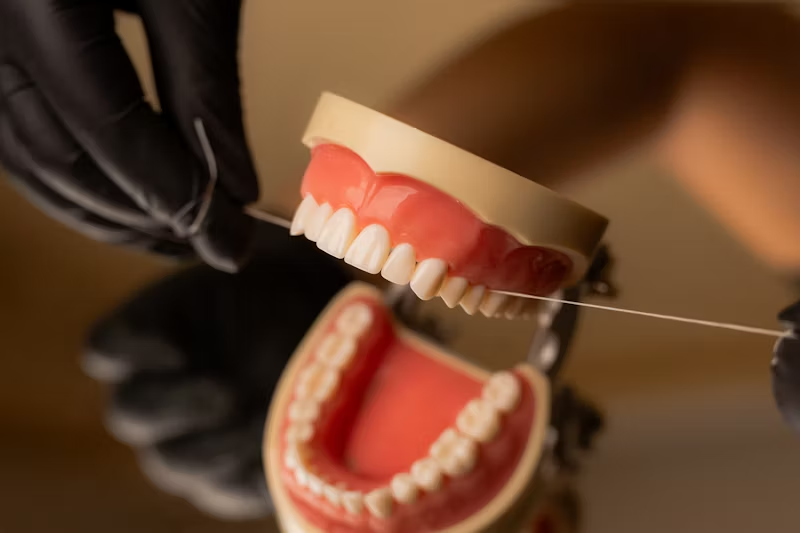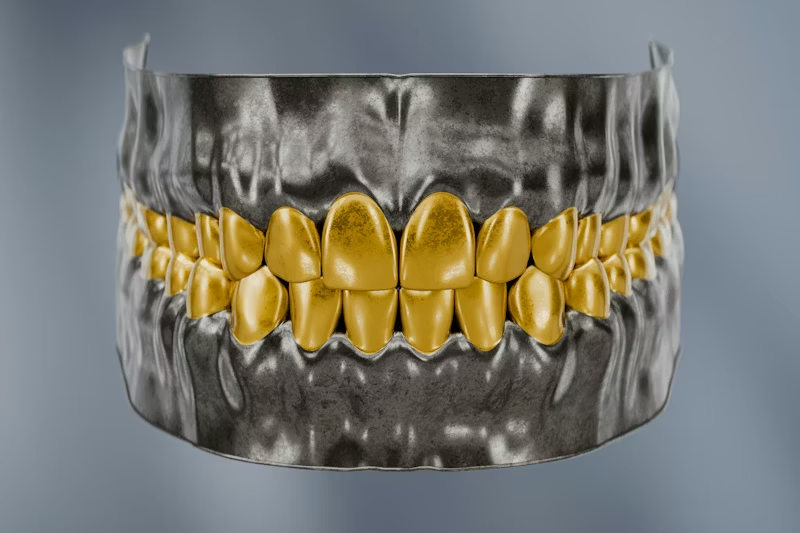A Practical Guide on How to Maintain Healthy Gums

To keep your gums in top shape, you really only need to focus on three things: consistent daily cleaning, a gum-friendly diet, and regular professional check-ups. That’s it. Nail these three, and you’re building a solid defence against plaque, inflammation, and more serious gum problems down the line.
Your Foundation for Healthy Gums Starts Today
We all want a great smile, but it’s easy to forget that healthy gums are the unsung heroes holding everything together. Think of them as the foundation of a house. If that foundation is weak, the whole structure is at risk. It’s the same with your teeth—they rely completely on the gum tissue and bone underneath for support.
The great news? Taking control of your gum health is simpler than you might think. It’s not about expensive gadgets or complicated routines. It’s about small, consistent habits that make a huge difference over time. Understanding how to look after your gums is the first and most important step in preventing common problems like gingivitis, which is the earliest stage of gum disease.
Why Healthy Gums Matter More Than You Think
While we often chase that pearly-white shine, the health of our gums is arguably far more critical for our long-term oral health. And it doesn’t stop there. Unhealthy gums can impact your entire body, as bacteria from gum inflammation can get into your bloodstream and contribute to other health issues. This connection turns proactive gum care into a crucial part of your overall well-being.
A proactive approach means going beyond just brushing your teeth. It’s about actively looking after the tissues that support them and stopping problems before they even have a chance to start.
This guide is all about giving you practical, actionable steps to build that strong foundation. We’ll cover daily habits, smart lifestyle choices, and how you can use modern dental solutions to stay on track. Whether you need urgent advice, cosmetic work, or a smarter way to straighten teeth, services like Toothfairy offer an accessible, modern approach to managing your dental care. By putting your gums first today, you’re investing in a healthier, more confident smile for years to come.
Mastering Your Daily Oral Hygiene Routine
We know why healthy gums are crucial, but how do we actually keep them that way day in and day out? It’s not just about a quick scrub in the morning and evening; it’s about the small details—the techniques and tools that make all the difference. Think of your daily habits as your frontline defence against the plaque and inflammation that lead to trouble.
At the heart of it all is, of course, brushing. But it has to be the right kind of brushing, one that focuses on that critical area where your gums and teeth meet. That’s where plaque tends to set up camp.
Rethinking Your Brushing Technique
Most of us brush on autopilot, which is completely understandable. But a few small tweaks to your technique can have a massive impact. Dentists often recommend the Modified Bass method, which sounds complicated but is actually a straightforward way to clean beneath the gumline without causing damage.
Here’s the gist of it:
- Angle Your Brush: Hold your toothbrush at a 45-degree angle to your gums, so the bristles are pointing right into that little pocket where plaque hides.
- Use Gentle Vibrations: Forget aggressive, sawing motions. Instead, use short, gentle, back-and-forth vibrations to loosen plaque from the tooth surface.
- Sweep and Roll: Once you’ve vibrated for a few seconds, simply roll or sweep the brush away from your gums, up towards the chewing surface of your tooth.
This method is brilliant because it cleans effectively without the harsh scrubbing that can cause your gums to recede over time. And please, always use a soft-bristled toothbrush. Medium or hard bristles might feel like they’re cleaning better, but they can easily damage your enamel and delicate gum tissue.
This simple diagram shows how these daily habits fit into the bigger picture of long-term gum health.

As you can see, your daily routine is the bedrock, supported by what you eat and the professional care you receive.
Choosing Your Cleaning Toolkit
Brushing is fantastic, but even the best technique can’t reach every nook and cranny. In fact, it misses roughly 40% of your tooth surfaces—the spaces between your teeth. This is why interdental cleaning isn’t just a nice-to-have; it’s absolutely essential for healthy gums.
- Traditional Floss: Still the gold standard for tight contacts. Nothing quite beats string floss for scraping plaque clean from the sides of teeth when you get the hang of it.
- Water Flossers: A great alternative, especially if you have braces, bridges, or just find flossing a real faff. These devices use a targeted stream of water to blast away plaque and food debris.
- Interdental Brushes: These look like tiny bottle brushes and are perfect for cleaning larger gaps between teeth. Many people find them much easier to manoeuvre than traditional floss.
The best tool is simply the one you’ll use properly and consistently every single day. Don’t be afraid to try a few different options to see what feels right for you and your mouth.
Navigating Oral Care with Clear Aligners
Keeping your gums in top shape needs a bit of extra attention when you’re straightening your teeth. While older, fixed braces can be tricky to clean around, modern removable aligners have made life much easier.
With removable aligners like those from Toothfairy, you can simply take them out to brush and floss as you normally would. This completely sidesteps the issue of plaque building up around brackets and wires, allowing you to maintain excellent gum health throughout your treatment. The golden rule is to clean both your teeth and your aligners thoroughly after every meal before popping them back in. This prevents food from getting trapped against your teeth and gums, which is a key part of how to maintain healthy gums while on your journey to a straighter smile.
How Your Diet Directly Impacts Your Gum Health
While your daily cleaning routine is your first line of defence, what you eat plays a surprisingly direct role in your oral health. This isn’t about jumping on a restrictive diet; it’s about making smart, gum-friendly choices. Every meal and snack can either arm your body against inflammation or, unfortunately, fuel the very bacteria you’re trying to remove.

Think of it this way: sugary foods and acidic drinks create a perfect storm for harmful bacteria. When these bacteria multiply, they produce acids that eat away at your tooth enamel and irritate your gums. This irritation is the first step towards inflammation and, eventually, gum disease. Consuming these items regularly essentially sabotages all your hard work with brushing and flossing.
Foods That Fuel Healthy Gums
On the flip side, certain foods contain powerful nutrients that actively support gum health by strengthening tissues and fighting inflammation. Making these a regular part of your diet is one of the best things you can do to maintain healthy gums from the inside out.
Here are some of your gums’ best friends:
- Vitamin C Powerhouses: Foods like oranges, kiwis, strawberries, and bell peppers are packed with vitamin C. This vital nutrient helps your body produce collagen, a key protein that maintains the integrity and strength of your gum tissue.
- Crunchy Vegetables and Fruits: Items like carrots, celery, and apples act a bit like natural toothbrushes. Their fibrous texture helps scrub away plaque as you chew, and they also stimulate saliva production—your mouth’s own natural cleaning agent.
- Leafy Greens: Spinach, kale, and other greens are rich in vitamin K, which is thought to play a role in bone health. That’s crucial for supporting the jawbone that anchors your teeth.
Turning every meal into an opportunity to nourish your gums creates a supportive internal environment. This makes your daily hygiene routine even more effective.
The Role of Inflammation and Your Diet
Chronic inflammation is a major driver of gum disease, and what you eat can either calm this inflammatory response or make it worse. Since gum disease is so closely linked to inflammatory responses, understanding what foods that cause inflammation is crucial for protecting your gums.
Foods high in refined carbohydrates and sugar—think white bread, pastries, and fizzy drinks—are well-known culprits. They can trigger inflammatory processes throughout the body, including in your gums. In contrast, incorporating anti-inflammatory foods like fatty fish (rich in omega-3s), nuts, and olive oil can help counteract this effect. By choosing your foods wisely, you’re directly managing one of the biggest risk factors for gum problems and reinforcing your entire oral care strategy.
Spotting the Early Warning Signs of Gum Trouble
One of the sneakiest things about gum problems is how quietly they begin. It’s easy to overlook the first subtle hints that something isn’t quite right. Healthy gums should be a pale pink colour, feel firm to the touch, and wrap neatly around the base of your teeth. The moment things start to shift, the signs can be minor, but catching them early is your best defence.

Most of us think bleeding is the only red flag, but that’s just one piece of the puzzle. This isn’t about panicking over every little thing; it’s about learning to tune in to what your body is telling you. A little awareness now can often reverse the issue completely and save you from more serious problems down the line.
Beyond a Little Blood: What to Really Look For
Seeing some pink on your toothbrush is the classic sign, but don’t stop there. Your gums can send out several other signals that they need a bit more attention.
Keep an eye out for these tell-tale signs:
- Red, Puffy Gums: Healthy gums are calm and flat. If you notice they look angry, swollen, or a deeper shade of red, especially right where they meet your teeth, that’s a clear sign of inflammation.
- Bad Breath That Won’t Quit: We all get bad breath now and then. But if you have a persistent unpleasant taste or smell that brushing and mouthwash can’t seem to shift, it could be a sign of the bacteria linked to gum disease.
- Receding Gums: Have you ever thought your teeth look a bit longer than they used to? That’s often a sign of gum recession, where the gum tissue starts to pull back, exposing more of the tooth.
Spotting one of these doesn’t mean you’re headed for disaster. Think of it as a gentle nudge to step up your cleaning routine and perhaps get a professional opinion.
Understanding Gingivitis: The First Stage
These early symptoms are usually pointing to one thing: gingivitis. This is the mildest and most common form of gum disease, and it’s caused by plaque building up and irritating the gumline.
The best part? Gingivitis is almost always completely reversible. A bit more focus on your daily brushing and flossing, coupled with a professional clean, can usually turn things around.
Think of these early signs as an alarm bell. Ignoring them allows gingivitis to progress into a much more serious condition called periodontitis, which can cause permanent damage to the bone that holds your teeth in place.
This is a far more common problem than you might think. In the UK, a recent survey found that nearly one in five adults (19%) had been told by a dental professional that they had gum disease. These statistics underscore just how vital regular dental visits and a consistent home care routine really are. You can learn more about UK oral health findings on gov.uk.
When It’s Time to Call in a Professional
It can be unsettling to notice these symptoms, but it’s always better to know what you’re dealing with. If you see signs like bleeding or swelling that don’t improve after a week of really diligent cleaning, it’s time to seek some expert advice.
Thankfully, getting that initial guidance is simpler than ever. For a quick and convenient assessment, a Toothfairy virtual consultation gives you direct access to a qualified dentist without leaving your home. They can assess your symptoms, help you figure out what’s going on, and advise on next steps, ensuring you get the care you need, right when you need it.
Why You Still Need to See a Dentist in the UK
Even if you’re a brushing and flossing champion at home, some things are simply out of your hands. Over time, plaque inevitably hardens into a tough, chalky deposit called tartar (or calculus, as we call it in the clinic). Once that happens, your toothbrush might as well be a feather duster – it just won’t budge it. This is precisely why professional dental care isn’t a ‘nice-to-have’; it’s your essential partner in keeping your gums healthy.
Think of a regular dental check-up as more than just a quick peek. It’s a full-on MOT for your mouth, where a dentist or hygienist can catch the very first whispers of a problem, often long before you’d ever notice a symptom. Being proactive is the name of the game here, stopping tiny issues from becoming big, painful, and expensive ones.
What to Expect From a Professional Clean
The star of the show when it comes to professional gum care is the classic “scale and polish.” It’s a straightforward two-part process designed to get rid of all the stubborn tartar your daily routine can’t handle.
First up is the “scaling.” This is where a dental professional uses special instruments to carefully and thoroughly remove tartar from your teeth, getting into all the nooks and crannies, including just below the gumline where the real trouble starts.
After the scaling, your teeth are “polished” to make the surfaces super smooth. This doesn’t just give you that incredible, just-left-the-dentist clean feeling; it also creates a slick surface that makes it harder for new plaque to get a foothold. It’s like hitting the reset button.
Don’t think of professional cleanings as an optional extra. They are absolutely fundamental to preventing gum disease. By clearing away that tartar buildup, we remove the very thing that irritates your gums and causes them to get inflamed and bleed.
This is a cornerstone of preventative dental care right across the UK. In fact, the latest NHS dental statistics show that 31% of all adult treatments in England involved a scale and polish, which really highlights how vital it is to the nation’s oral health. And while getting an appointment can sometimes be tricky, it’s worth noting that 90% of patients who had a recent appointment were happy with their NHS care. You can dig into the numbers yourself in the official NHS dental statistics for England 2023-24 report.
Getting Past Dental Nerves and Finding Care
Look, we get it. For a lot of people, the thought of visiting the dentist brings on a cold sweat. But dental practices in the UK have come a long way. The focus now is all about patient comfort, using gentle techniques and creating a genuinely welcoming space to put you at ease. Never be afraid to have a chat with the dental team about your worries before you even sit in the chair.
Sometimes the stress isn’t about the treatment itself, but about navigating the system or dealing with a sudden, unexpected problem. That’s where a service like Toothfairy can be a real game-changer.
Maybe you’re struggling to find affordable care, have woken up with a dental emergency, or are curious about a smarter, more affordable way to straighten your teeth. We offer an easier way to get professional support, making sure you’ve always got someone in your corner for your long-term gum health.
Your Questions on Gum Health Answered
It’s natural to have questions when you’re trying to look after your oral health. From figuring out the best daily routine to wondering how something like straightening your teeth might affect your gums, getting clear answers is the first step. Let’s tackle some of the most common questions we hear.
Can Gum Disease Be Reversed Once You Have It?
Yes, but catching it early is absolutely key. The first stage, called gingivitis, is usually completely reversible. This is when your gums are just starting to show signs of inflammation. If you step up your daily brushing and flossing and get a professional clean to remove any stubborn tartar, your gums can often bounce back to perfect health.
However, if gingivitis is left to progress into periodontitis, the damage becomes permanent. At this more advanced stage, the bone and tissues holding your teeth in place start to break down. While treatment can halt the disease and prevent it from getting worse, the lost bone won’t grow back on its own. This is precisely why it’s so important to recognise those early warning signs.
Are Electric Toothbrushes Better for Gums Than Manual Ones?
Honestly, the best toothbrush is the one you’ll use properly every single day. Having said that, many people find an electric toothbrush gives them a clear advantage in the fight against plaque.
Here’s why they can be such a good investment for your gum health:
- Built-in Timers: Most have a two-minute timer, which takes the guesswork out of brushing for the dentist-recommended time.
- Pressure Sensors: It’s so easy to brush too hard without realising it, which can damage your gums and lead to recession. Many electric models will flash or vibrate to warn you if you’re pushing too hard.
- Superior Cleaning Action: The oscillating and vibrating heads do the hard work for you, breaking up and sweeping away significantly more plaque than a manual brush can.
How Do Clear Aligners Impact My Gum Health?
Any kind of orthodontic treatment means you need to be extra vigilant with your oral hygiene. One of the standout benefits of clear aligners over traditional fixed braces is that you can take them out. This makes a huge difference, as it lets you brush and floss just as you normally would, avoiding the plaque build-up that can easily happen around metal brackets and wires.
If you’re using a system like Toothfairy for a smarter and more affordable way to straighten your teeth, keeping your gums healthy is very achievable. The secret is just to be diligent. You need to clean your teeth and the aligners themselves after every single meal before popping them back in. This prevents food and sugar from getting trapped against your teeth and gums.
A bit of bleeding when you first start a flossing routine is quite normal. It’s usually just a sign of some existing inflammation. Don’t let it put you off! If you keep at it gently every day, the bleeding should stop within a week or two as your gums heal. If it doesn’t, that’s your cue to get some professional advice.
Ready to take control of your dental health, from achieving a straighter smile to getting immediate advice for an emergency? With Toothfairy, you get access to expert dental care that’s smarter, more affordable, and fits into your life. Discover your options today at https://www.toothfairyapp.co.uk.
Last updated on November 24, 2025

Toothfairy Care Team
Toothfairy, is the world's smartest dental app, that connects patients to a dentist for a range of issues, from emergencies, cosmetics, prescriptions to virtual exams.
Toothfairy Care Team
Toothfairy, is the world's smartest dental app, that connects patients to a dentist for a range of issues, from emergencies, cosmetics, prescriptions to virtual exams.





